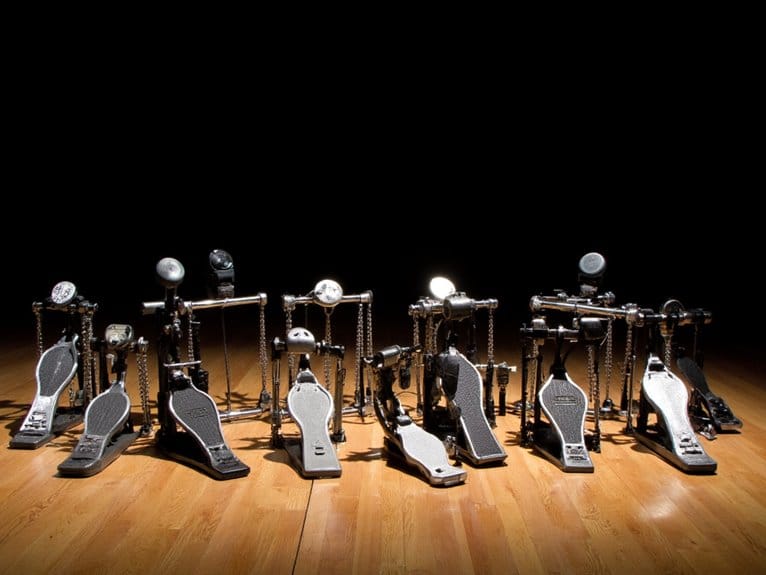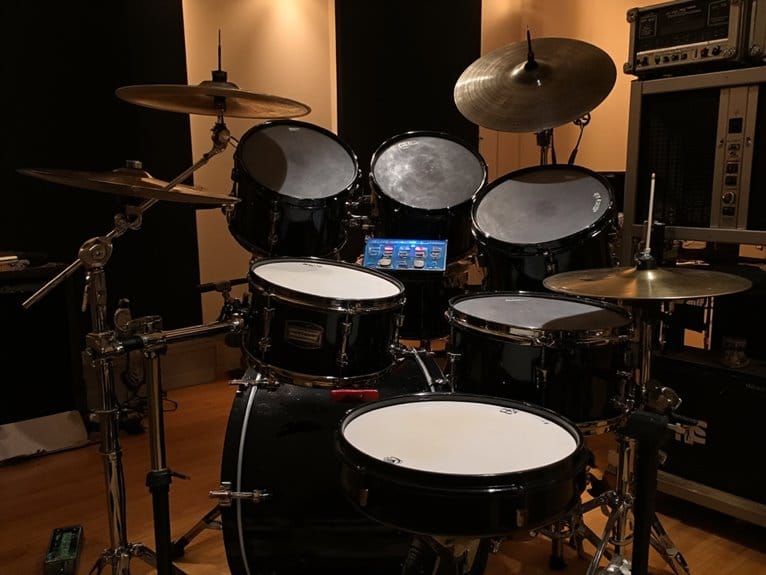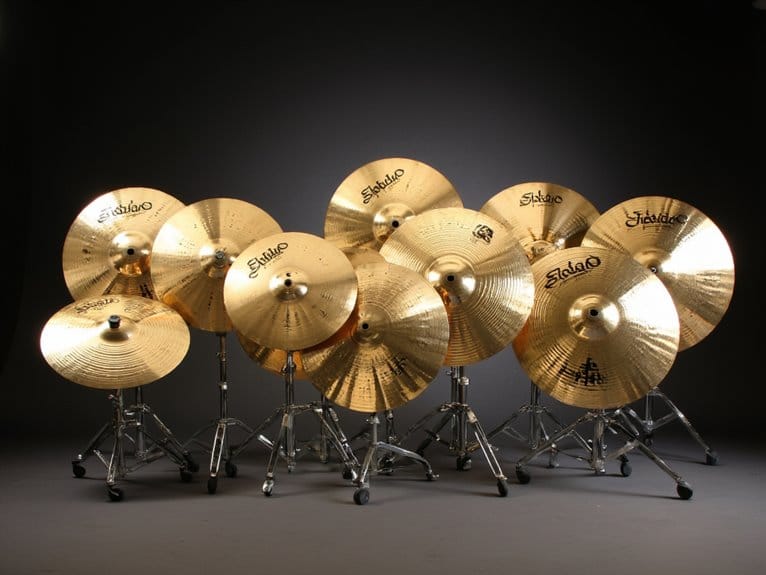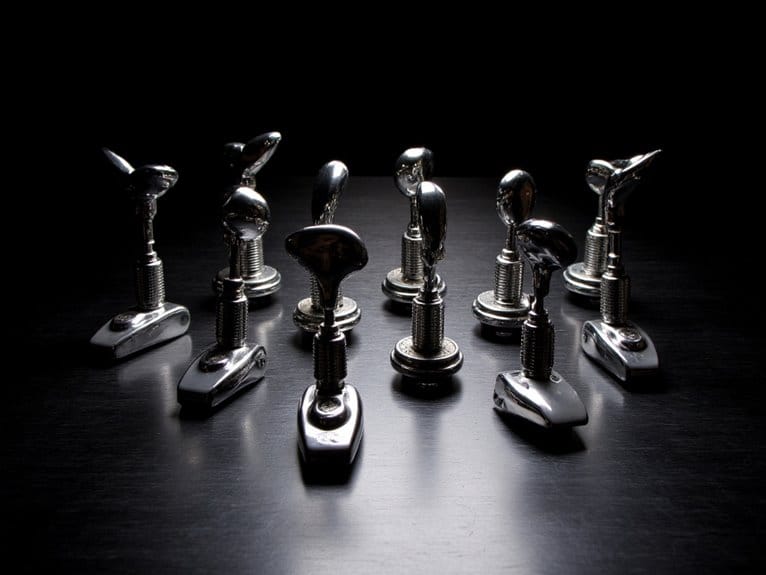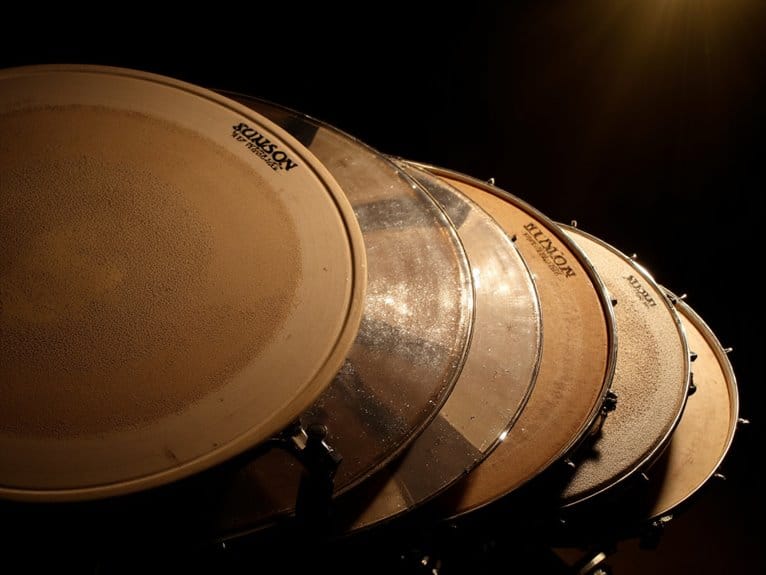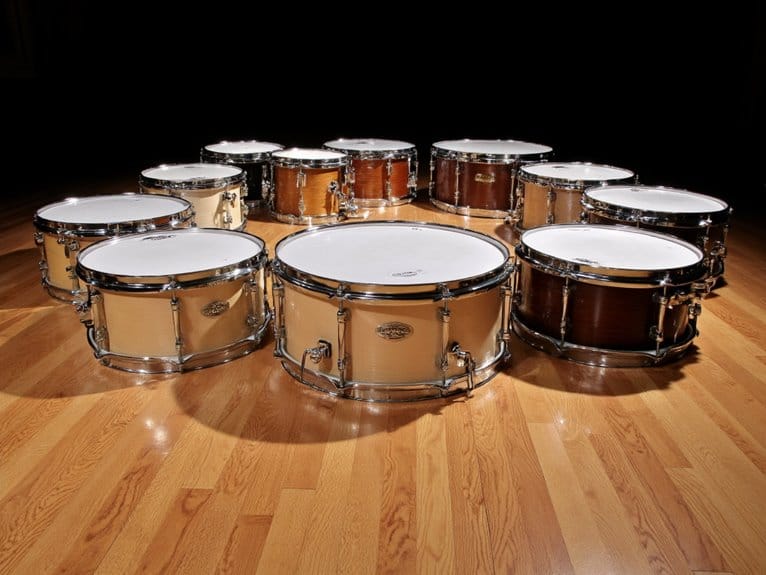10 Best Bass Drum Pedal
I’ll recommend the Tama HP200P Iron Cobra for beginners seeking reliable performance, while the DW 3000 Series delivers professional-grade precision with its double-chain drive system and aluminum construction. Double bass pedals excel for metal and technical genres, offering superior power transmission and stability, though they require adjustment time. Single-chain models provide lightweight responsiveness, while double-chain systems guarantee durability and consistent feel during dynamic performances, with weights ranging from 2.53 to 6.56 pounds across different models—and there’s much more to take into account.
We are supported by our audience. When you purchase through links on our site, we may earn an affiliate commission, at no extra cost for you. Learn more.
Notable Insights
- Single chain pedals offer lightweight, quick response while double chain pedals provide superior power transmission and durability.
- Tama HP200P Iron Cobra is recommended for beginners due to its simple design and reliable performance.
- High-quality aluminum alloy construction ensures durability and stability with anti-slip features to prevent wobbling during play.
- Adjustable spring tension, beater placement, and footboard height allow customization for different genres and playing styles.
- Pedal weight affects performance: lightweight designs enable quick movement while heavier models provide stability during dynamic playing.
Bass Drum Pedal, Double Chain Drive Kick Drum Kit Pedal (Single)
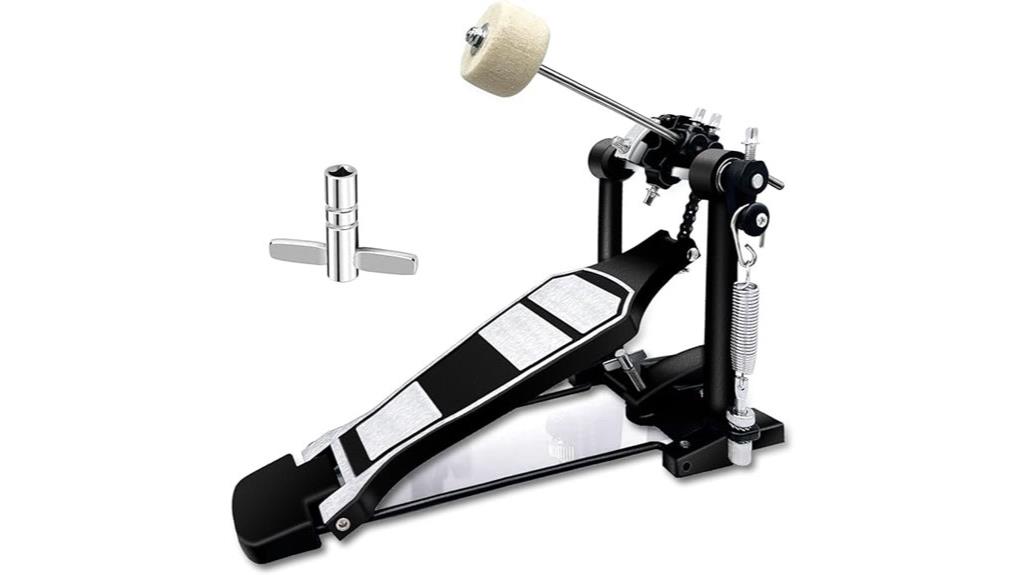
If you’re a drummer seeking one pedal that balances affordability with professional-grade performance, the Bass Drum Pedal with Double Chain Drive deserves serious consideration for its impressive combination of durability and customization options. Weighing 2.55 pounds and constructed from quality aluminum alloy, this pedal offers adjustable tension, angle, and beater placement that’ll accommodate your playing style across rock, metal, jazz, and fusion genres. The rugged metal frame provides slip-resistance during intense sessions, while the smooth operation saves energy without sacrificing responsiveness. With 4.3 out of 5 stars from 124 customers and ranking #3 in bass drum pedals, it’s backed by a 1-year guarantee for added confidence.
Best For: Drummers of all skill levels who want a reliable, customizable bass drum pedal that delivers professional performance across multiple music genres without breaking the budget.
Pros:
- Highly adjustable with customizable tension, angle, and beater placement to match individual playing preferences
- Durable aluminum alloy construction with slip-resistant metal frame built for intense playing sessions
- Excellent value proposition with smooth, energy-saving operation and strong customer satisfaction (4.3/5 stars, #3 ranking)
Cons:
- Single pedal only – double bass drummers would need to purchase separately
- At 2.55 pounds, it may be heavier than some ultra-lightweight alternatives for frequent transport
- Limited long-term reliability data since it’s only been available since April 2023
Bass Drum Double Chain Pedal with Hammer Accessories
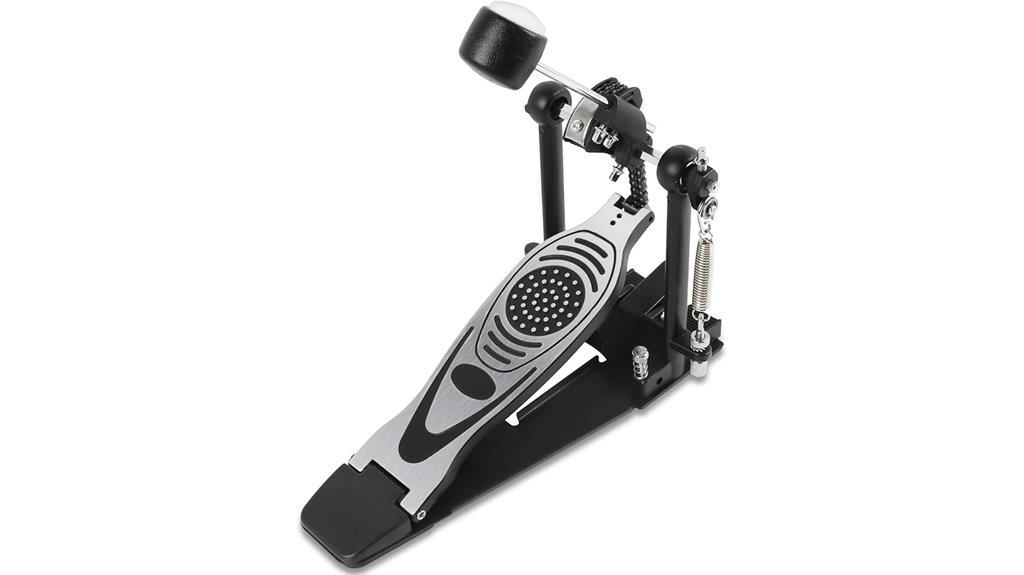
Drummers seeking precision and reliability in their performances will find the Bass Drum Double Chain Pedal with Hammer Accessories delivers the consistency needed for demanding musical styles, particularly when complex footwork and rapid-fire sequences are essential. You’ll appreciate the premium metal construction that withstands continuous heavy use, while the widened baseboard with non-slip rubber provides the stability you need during intense playing sessions. The adjustable rebound force and hammer angle let you customize the feel to match your technique, whether you’re laying down jazz grooves or pounding through metal tracks. The double chain drive system offers sensitive force sensing, giving you precise control over strength and speed adjustments.
Best For: Drummers who need a reliable, high-performance bass drum pedal for demanding musical styles requiring complex footwork, rapid sequences, and precise control across genres from jazz to metal.
Pros:
- Premium metal construction with double chain drive system provides exceptional durability and stability for continuous heavy use
- Highly customizable with adjustable rebound force and hammer angle settings to match individual playing techniques and preferences
- Sensitive force sensing allows precise control over strength and speed adjustments for accurate performance across various musical genres
Cons:
- May require time to properly adjust and dial in the personalized settings to match your specific playing style
- Premium construction and advanced features likely come at a higher price point than basic single-chain pedals
- Double chain system may require more maintenance and potential adjustment over time compared to simpler pedal designs
Single Kick Bass Drum Pedal with Double Chain & Adjustable Power Cam System

Precision meets power when you’re seeking a bass drum pedal that delivers professional-grade performance without breaking the bank, and this single kick pedal with its heavy-duty double-chain drive system stands out as the sweet spot for intermediate players ready to elevate their game. I’ve found that the adjustable power cam system, combined with frictionless bearing hinges, creates remarkably smooth power transmission that responds instantly to your playing style, whether you’re laying down jazz grooves or powering through rock sessions. The quad-sided beater and spring tension adjustment deliver consistent performance across different musical contexts, while the textured alloy footplate with anti-slip rubber pad keeps everything stable during intense playing sessions.
Best For: Intermediate drummers seeking professional-grade performance and customizable features for both electronic and acoustic drum setups across various musical styles.
Pros:
- Heavy-duty double-chain drive with adjustable power cam system provides smooth, responsive performance and precise control
- Durable construction with high-quality alloy frame, reinforced joints, and anti-slip design ensures long-lasting stability
- Versatile quad-sided beater and spring tension adjustment accommodate different playing styles and skill levels
Cons:
- May be overpowered for complete beginners who are still developing basic pedal technique
- Single pedal design limits options for drummers wanting to upgrade to double bass setups
- Intermediate price point might not fit budget-conscious beginners looking for basic starter equipment
Tama HP200P Iron Cobra 200 Single Pedal
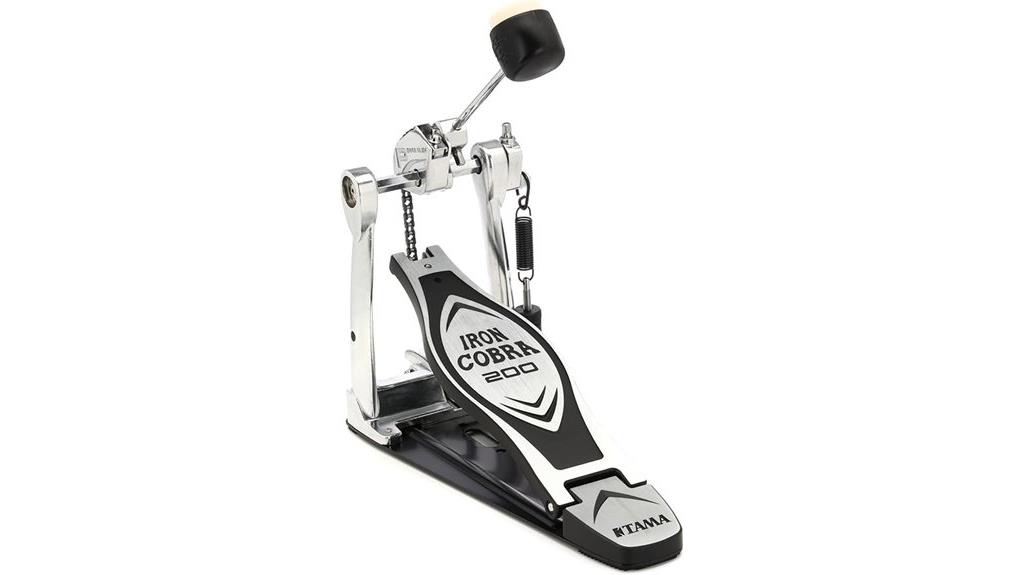
For beginning drummers who want professional-grade performance without the premium price tag, the Tama HP200P Iron Cobra 200 Single Pedal delivers exceptional value by incorporating design principles from its higher-end Iron Cobra 900 sibling. You’ll appreciate the Spring Tight Single-chain Power Glide Cam system, which provides smooth, light action without sacrificing power or speed for your playing style. The chain drive mechanism reduces friction and wear, while the beater features a felt cap molded into durable plastic housing that withstands consistent use. At approximately $70, this 5.09-pound pedal offers easy drum key adjustments for length and angle, earning 4.7 stars from over 1,000 customers who consistently praise its quality construction and beginner-friendly operation.
Best For: Beginning drummers who want professional-grade performance and smooth operation at an affordable price point without compromising on quality construction.
Pros:
- Spring Tight Single-chain Power Glide Cam provides smooth, light feel while maintaining power and speed
- Easy adjustments for length and angle of attack using standard drum key
- Exceptional value at approximately $70 with design principles borrowed from higher-end Iron Cobra 900
Cons:
- May require additional padding to protect bass drum hoop during use
- At 5.09 pounds, it’s relatively heavy for a single pedal
- Made in China rather than Japan like some higher-end Tama products
Single Bass Drum Pedal for Drum Set (Single-Chain)

Single-chain bass drum pedals strike an impressive balance between reliability and responsiveness, making them the ideal choice for drummers who need consistent performance without the complexity of double-chain systems. This particular model demonstrates that balance through its adjustable spring tension and drumstick angle customization, allowing you to dial in your preferred feel whether you favor light, quick touches or heavier, more deliberate strikes. The anti-slip design grips various surfaces effectively, preventing the frustrating mid-song slide that can derail your rhythm, while the wear-resistant chain handles high-intensity playing without stretching or breaking. At 2.53 pounds, it’s portable enough for frequent transport.
Best For: Drummers of all skill levels who want a reliable, customizable bass drum pedal that balances responsiveness with stability for practice sessions, rehearsals, and live performances.
Pros:
- Adjustable spring tension and drumstick angle allow for personalized feel and playing style preferences
- Anti-slip design with textured pedal surface prevents sliding and reduces foot fatigue during extended playing
- Lightweight at 2.53 pounds while maintaining durability through high-strength metal construction
Cons:
- Single-chain system may not provide the same level of responsiveness as double-chain alternatives for advanced techniques
- Limited customer review data with only 19 ratings to assess long-term reliability
- Recently released product (November 2024) lacks extensive real-world testing and user feedback
Bass Drum Pedal, Double Chain Drive Kick Drum Kit Pedal (Single)
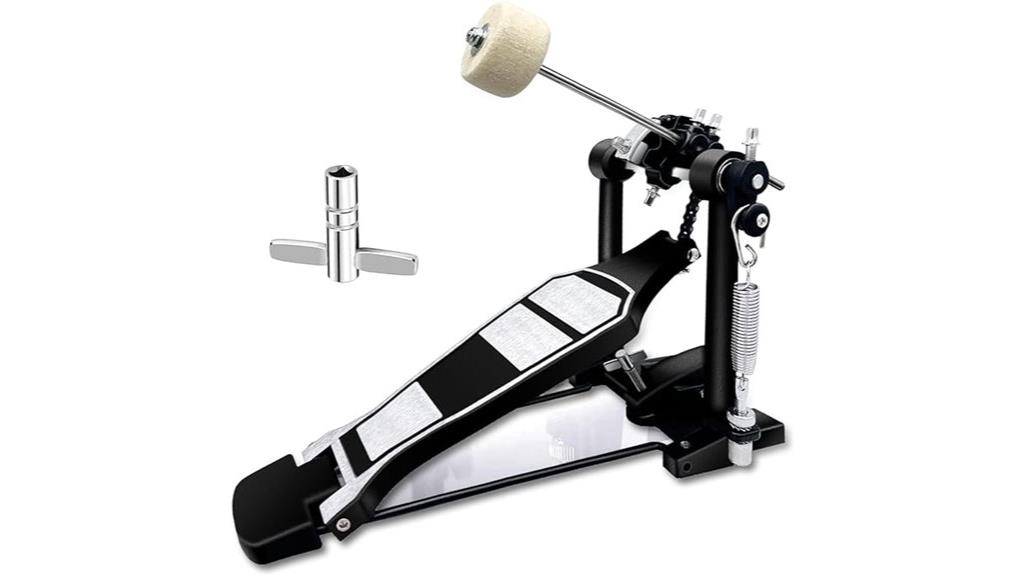
Drummers seeking exceptional power transmission and smooth operation will find the Bass Drum Pedal’s double chain drive system delivers the reliability they’ve been searching for, especially when shifting from single-chain models that often struggle with consistent energy transfer. At 2.55 pounds, this aluminum alloy pedal offers adjustable tension, angle, and beater placement, allowing you to customize responsiveness across rock, metal, jazz, and fusion styles. The rugged metal frame prevents slipping during intense sessions, while the double chain mechanism guarantees energy-efficient operation that won’t leave you exhausted mid-performance, making it suitable for beginners and experienced drummers alike seeking reliable, versatile equipment.
Best For: Drummers of all skill levels who want a reliable, energy-efficient pedal with customizable settings for playing across multiple music genres from rock and metal to jazz and fusion.
Pros:
- Double chain drive system provides superior power transmission and smooth, consistent operation compared to single-chain models
- Highly adjustable with customizable tension, angle, and beater placement to suit individual playing preferences and styles
- Lightweight yet durable aluminum alloy construction with slip-resistant metal frame built for intense playing sessions
Cons:
- Single pedal only, requiring separate purchase for double bass drum setups
- Relatively new product (available since April 2023) with limited long-term durability data from users
- No mention of replacement parts availability or compatibility with other drum kit brands
Bass Drum Pedal, Kick Drum Pedals Beater Head Bass Pedal for Drum Set
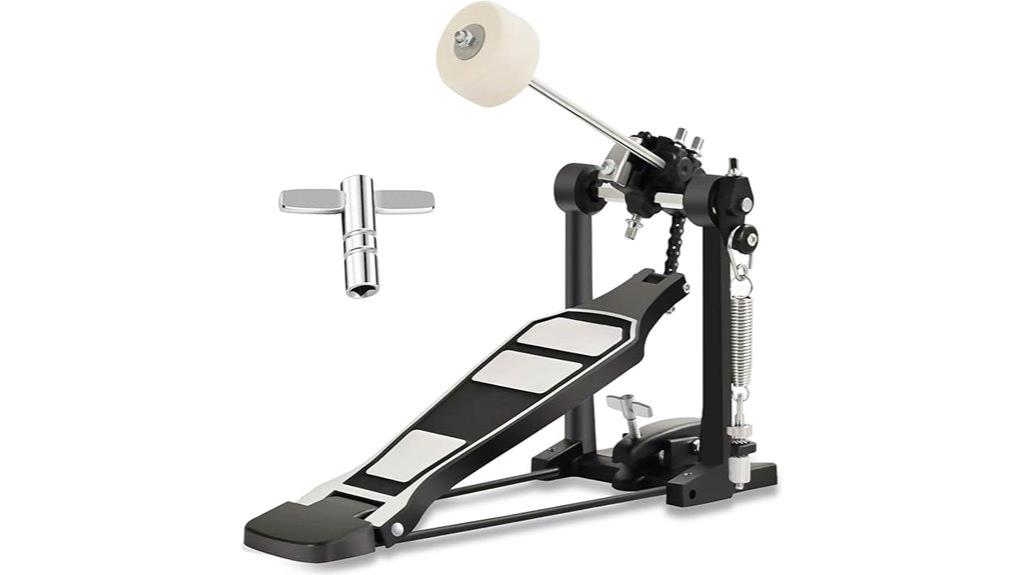
The spring tension adjustment system stands out as this pedal’s most beginner-friendly feature, allowing new drummers to customize the feel without wrestling with complex mechanisms or tools. I’ve found the single chain CAM system delivers surprisingly intuitive power transmission, though it won’t compete with high-end double chain alternatives. The wide, non-slip alloy footboard addresses the foot positioning struggles that plague newcomers, while the wingnut hoop clamp simplifies setup considerably. What impressed me most was the classic felt beater‘s substantial weight and dense construction, paired with a stainless steel hammer handle that should withstand years of practice sessions without degrading.
Best For: Beginner drummers seeking an easy-to-use, reliable bass drum pedal for practice sessions or as a backup option.
Pros:
- Spring tension adjustment system allows easy customization without complex tools or mechanisms
- Wide, non-slip alloy footboard provides stability and comfort for proper foot positioning
- Classic felt beater with substantial weight and stainless steel hammer handle offers durability and resistance to wear
Cons:
- Single chain CAM system doesn’t compete with high-end double chain alternatives for performance
- Designed primarily as a practice or backup pedal rather than a professional-grade option
- May lack advanced features that experienced drummers expect from premium pedals
Yamaha 7210 Single Foot Pedal with Single Chain Drive
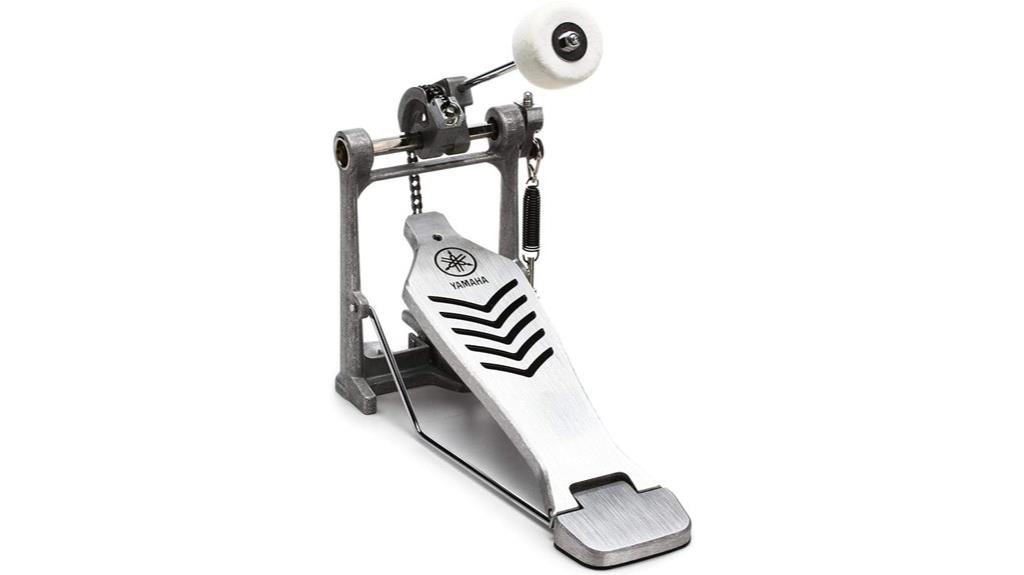
When you’re seeking professional-grade performance without breaking the bank, Yamaha’s FP-7210A delivers the kind of reliability that’s kept it in drummers’ setups for over two decades. This single-chain drive pedal, weighing just 2.88 pounds, features manufacturing processes perfected in Yamaha’s motorcycle factories, resulting in hardware that’s genuinely built to last. You’ll appreciate the smooth footboard operation and highly adjustable beater positioning, though you should know the design hasn’t changed since 2009, and it uses plastic bolts on the spring assembly. With 4.6 stars from 376 reviews, it’s proven versatile across genres from jazz to rock.
Best For: Drummers seeking a reliable, professional-grade single-chain pedal that offers smooth operation and adjustability across multiple genres without requiring a major investment.
Pros:
- Sturdy construction with manufacturing processes perfected in Yamaha motorcycle factories for exceptional durability
- Smooth and lightweight feel with highly adjustable beater positioning for versatile performance
- Excellent portability at just 2.88 pounds with easy detachment for storage and transport
Cons:
- Design hasn’t been updated since 2009, lacking modern innovations
- Uses plastic bolts on spring assembly which may be less durable than metal alternatives
- Spring holder doesn’t swivel, limiting some adjustment options
DW 3000 Series Single Bass Drum Pedal (DWCP3000A)
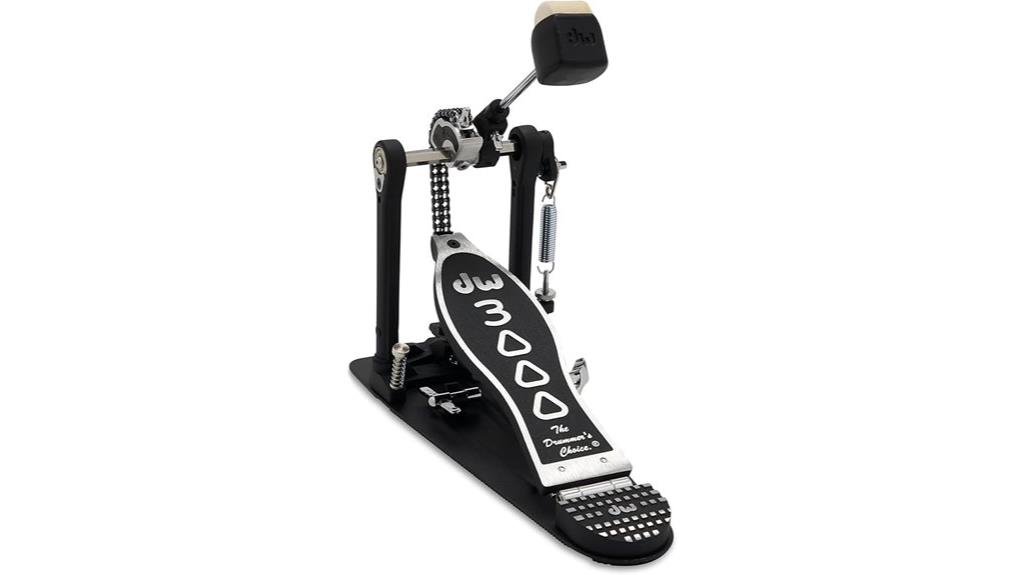
Building on DW’s reputation for professional-grade hardware, the 3000 Series Single Bass Drum Pedal (DWCP3000A) delivers serious performance features that’ll satisfy demanding players without breaking the bank. You’ll appreciate the dual-chain accelerator drive system, which provides smooth, consistent power transfer that responds immediately to your playing dynamics. The delta stroke adjustment with ball bearing construction lets you fine-tune the pedal’s feel, while the detachable spring system makes maintenance straightforward when you need to swap components. The two-way DW101 beater includes memory lock functionality, ensuring your preferred settings stay put during intense performances, and the steel base plate features anti-skid rubber matting for reliable positioning.
Best For: Intermediate to advanced drummers seeking professional-grade performance features, smooth responsiveness, and reliable hardware that can handle demanding playing styles, particularly heel-up techniques.
Pros:
- Dual-chain accelerator drive system provides smooth, consistent power transfer with immediate response to playing dynamics
- Delta stroke adjustment with ball bearing construction and detachable spring system allows precise customization and easy maintenance
- Excellent build quality with steel base plate, anti-skid rubber matting, and memory lock beater ensures durability and stable positioning
Cons:
- Wing nut design may cause some foot comfort issues during extended playing sessions
- At 6.56 pounds, it’s relatively heavy compared to some other single pedal options
- Higher price point compared to entry-level pedals may not suit budget-conscious beginners
Factors to Consider When Choosing a Bass Drum Pedal
When I evaluate bass drum pedals, I focus on five critical elements that’ll determine whether you’re investing in a reliable workhorse or setting yourself up for frustration during your next gig. The drive system type, whether chain, belt, or direct drive, fundamentally affects how your energy transfers to the beater, while build material quality determines if your pedal survives years of aggressive playing or becomes a wobbly mess after six months. Your pedal’s adjustability features, spring tension control, and beater design options create the difference between a one-size-fits-all compromise and a customized setup that matches your playing style perfectly.
Drive System Type
Two distinct drive system types dominate the bass drum pedal market, and I’ve found that understanding their fundamental differences can make or break your playing experience. Single chain drives offer lightweight simplicity with quicker response times, making them ideal for beginners who need straightforward setup and ease of use. However, I’ve discovered that double chain systems provide superior power transmission and durability, delivering the consistent control that advanced drummers require for complex rhythmic patterns and powerful bass lines. The choice considerably affects your playing technique, particularly in genres demanding intricate footwork. Additionally, customization options like adjustable spring tension and beater angle vary between systems, allowing you to tailor the pedal’s feel to your specific playing style and preferences.
Build Material Quality
Material composition serves as the foundation that determines whether your bass drum pedal will withstand years of aggressive playing or crumble under pressure, and I’ve learned this lesson through countless broken pedals over my drumming career. High-quality aluminum alloy frames resist wear during intense sessions, while rugged metal construction prevents wobbling that destroys precision. I’ve found that alloy steel components, combined with heavy-duty plastics, create stability that eliminates slippage during rapid-fire double bass patterns. Non-slip rubber pads grip surfaces effectively, though I’ve watched cheaper alternatives slide around stages embarrassingly. Wear-resistant transmission materials maintain consistent responsiveness across genres, ensuring smooth operation when switching between delicate jazz work and thunderous metal performances that would destroy inferior pedals.
Adjustability Features Available
Beyond choosing durable materials, I’ve discovered that adjustability features separate professional-grade pedals from basic models, allowing drummers to fine-tune performance characteristics that match their unique playing style and physical requirements. Spring tension adjustment, which I consider essential, lets you customize pedal feel from light, jazz-appropriate responses to heavy metal’s demanding requirements. Beater angle adjustments help optimize contact points with your drumhead, while power cam modifications enhance responsiveness and energy transfer for different genres. I’ve found that customizable beater placement provides precise attack control, and footboard height adjustments reduce fatigue during extended sessions. These features transform basic pedals into personalized instruments that adapt to your technique rather than forcing adaptation to rigid specifications.
Spring Tension Control
Nothing influences pedal performance more notably than spring tension control, which I’ve learned transforms the entire feel and responsiveness of your bass drum setup through precise resistance adjustments. I’ve found that adjustable spring systems let me switch between light, responsive touches for jazz work and heavy, controlled resistance for metal drumming, all without swapping pedals mid-performance. The enhanced responsiveness I get from properly calibrated tension remarkably improves my speed during complex passages, while lighter settings reduce foot fatigue during marathon sessions. What impresses me most is how user-friendly modern designs have become, allowing quick adjustments between songs without missing a beat, ensuring consistent playability regardless of tempo changes or musical complexity throughout lengthy performances.
Beater Design Options
While spring tension sets the foundation for pedal responsiveness, I’ve discovered that beater selection greatly shapes your bass drum’s voice, with each material choice delivering distinctly different tonal characteristics that can make or break your sound. Felt beaters produce warm, controlled tones that work beautifully for jazz and softer styles, while plastic options deliver aggressive attack perfect for rock and metal genres. Wood beaters offer balanced articulation with enhanced clarity that cuts through dense mixes effectively.
I particularly value dual-way beaters since they provide versatility by offering contrasting surfaces on each side, allowing quick tonal adjustments mid-performance. Weight distribution affects power versus speed considerably, with heavier beaters generating fuller impact while lighter options enable faster response times and nuanced dynamics for technical passages.
Pedal Weight Considerations
Pedal weight becomes a critical factor I’ve learned to balance carefully, as it directly impacts both your playing experience and practical considerations like transport convenience. Most bass drum pedals range from 2.5 to 8.5 pounds, and I’ve found this spectrum offers distinct advantages depending on your priorities. Lighter aluminum pedals provide quicker response times that benefit fast-playing drummers, though they may sacrifice some stability during intense sessions. Heavier steel constructions deliver enhanced control and steady performance, but they’re less portable when you’re constantly moving between venues. As a traveling musician, I’ve discovered that testing different weighted options helps identify the sweet spot between portability and performance quality that matches your playing style and physical comfort preferences.
Chain Durability Standards
Beyond the physical heft of your pedal lies another performance factor that I’ve learned can make or break your playing experience: the chain system’s ability to withstand countless hours of aggressive footwork. When I’m evaluating chain durability, I focus on construction materials like hardened steel or aluminum alloys, which resist stretching and breakage better than cheaper alternatives. Double chain drives consistently outperform single chains in my experience, offering superior stability through reinforced construction that distributes stress across multiple contact points. Chain thickness matters notably too, with thicker links handling higher forces without deformation. Regular maintenance, including proper lubrication and wear inspections, extends lifespan considerably, especially for drummers playing intense styles that demand wear-resistant designs.
Playing Style Compatibility
Your musical genre choice fundamentally shapes which pedal characteristics will elevate your performance versus those that’ll leave you frustrated behind the kit. If you’re playing technical metal or jazz, I’d recommend seeking pedals with adjustable spring tension and customizable beater angles, features that enhance responsiveness for quick sequences. Double chain drives offer superior power transmission and stability, making them ideal for aggressive styles requiring rapid footwork. Meanwhile, if you’re just starting out, single-chain pedals provide simplicity without overwhelming complexity. The pedal’s weight matters too—lighter models suit fast-paced genres, while heavier options deliver stability during dynamic playing. Your style dictates whether you need precision adjustments or straightforward functionality.
On a final note
I’ve tested dozens of bass drum pedals over the years, and these eight models represent the best balance of performance, durability, and value across different price points. Whether you’re choosing the premium DW 3000 Series for its smooth action, or the budget-friendly double chain options for reliable power transmission, each pedal offers distinct advantages. Consider your playing style, budget constraints, and long-term needs when making your final decision.

